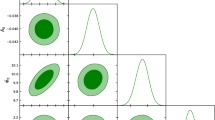Summary
The atomic gauge of conformally invariant theories of the Weyl-Dirac type is identified with the flat gauge and the corresponding field equations for matter are investigated. Well-known solutions ofσ 4-theories are found. In particular, instantons and merons appear as by-products of appropriate distributions of energy and momentum and thus receive a hydrodynamical interpretation. Other periodic-wave solutions are also found. In general, matter fields appear in the scheme as distortions of the large-scale structure of space-time and are, therefore, gravitational in nature. In order for this metrical substructure to be small, the «cosmological» constant must be extremely large, of the order of the inverse square of a length of particle dimensions.
Riassunto
S'identifica il gauge atomico di teorie conformemente invarianti del tipo di Weyl-Dirac con il gauge piatto e si studiano le corrispondenti equationi di campo per la materia. Si trovano soluzioni ben note della teoriaϕ 4. In particolare compaiono istantoni e meroni come sottoprodotti di distribuzioni appropriate di energia e impulso e quindi ricevono un'interpretazione idrodinamica. Si trovano anche altre soluzioni d'onda periodica. In generale, campi di materia compaiono nello schema come distorsioni della struttura a scala ampia dello spazio tempo e sono quindi gravitazionali in natura. Affinché questa sottostruttura metrica sia piccola, la costante cosmologica deve essere estremamente grande, dell'ordine dell'inverso del quadrato di una lunghezza dimensioni particellari.
Резюме
Атомная калибровка конформно инвариантных теорий типа Вейля-Дирака отождествляется с плоской калибровкой и исследуются соответствующие полевые уравнения для вещества. Получаются хорошо известные решения дляϕ 4-теорий. В частности, инстантоны и мероны появляются ка побочный результат соответствующих распределений для энергии и импульса. Предлагается гидродинамическая интерпретация. Также получаются другие периодические волновые решения. В общем случае, поля вещества возникают в предложенной схеме, как искажения крупномасштабной структуры пространства-времени, и, следовательно, являются гравитационными по природе. Чтобы эта метрическая субструктура была малой, «космологическая» постоянная должна быть чрезвычайно большой, порядка обратного крадрата размеров частиц.
Similar content being viewed by others
References
P. A. M. Dirac:Proc. R. Soc. London Ser. A,333 403 (1973);338, 439 (1974);Comment. Pontif. Acad. Sci.,2, 1 (1973).
V. Canuto, S-H. Hsieh andP. J. Adams:Phys. Rev. Lett.,39, 429 (1977);V. Canuto, P. J. Adams, S-H. Hsieh andE. Tsiang:Phys. Rev. D,16, 1643 (1977);V. Canuto andJ. Lodenquai:Astrophys. J.,211, 342 (1977);V. Canuto:Riv. Nuovo Cimento 1, 1 (1978).
D. Gregorash andG. Papini:Nuovo Cimento B,63, 487 (1981);Phys. Lett. A,82, 67 (1981).
A. Belavin, A. Polyakov, A. Schwartz andYu. Tyupkin:Phys. Lett. B,59, 85 (1975).
V. De Alfaro, S. Fubini andG. Furlan:Phys. Lett. B,65, 163 (1976);72, 203 (1977);73, 463 (1978).
G. Papini:Phys. Lett. A,75, 173 (1980);Lett. Nuovo Cimento,20, 613 (1977).
S. Fubini:Nuovo Cimento A,34, 521 (1976).
G. Petiau:Suppl. Nuovo Cimento,9, 542 (1958).
G. Papini andM. Weiss:Phys. Lett. A,89, 329 (1982).
E. Kamke:Differentialgleichungen, Lösungmethoden und Lösungen (New York, N. Y., 1959).
See, for instance,F. Halbwachs, G. Lochak andJ-P. Vigier:C. R. Acad., Sci. 241, 692 (1955);T. Takabayashi:Phys. Rev.,102, 292 (1956);J. Tiomno:An. Acad. Bras. Cienc.,27, 259 (1955).
G. Papini:Lett. Nuovo Cimento,2, 1370 (1971);5, 478 (1972);R. Jackiw andC. Rebbi:Phys. Rev. Lett.,36, 1116 (1976);A. S. Goldhaber:Phys. Rev. Lett.,36, 1122 (1976).
D. Gregorash andG. Papini:Nuovo Cimento B,64, 55 (1981).
A. Einstein: inCinquant'anni di Relatività a cura diM. Pantaleo (Firenze, 1955).
M. A. Markov:Cosmology and Elementary Particles, Lecture Notes, International Centre for Theoretical Physics IC-71-33 (Trieste, 1971);P. Caldirola, M. Pavšič andE. Recami:Nuovo Cimento B,48, 205 (1978).
Author information
Authors and Affiliations
Additional information
To speed up publication, the author of this paper has agreed to not receive the proofs for correction.
Work supported in part by the Natural Sciences and Engineering Research Council of Canada.
Traduzione a cura della Redazione.
Переведено редакцией.
Rights and permissions
About this article
Cite this article
Papini, G. The atomic gauge in conformally invariant theories of the Weyl-Dirac type. Il Nuovo Cimento B 70, 113–127 (1982). https://doi.org/10.1007/BF02814016
Received:
Published:
Issue Date:
DOI: https://doi.org/10.1007/BF02814016




